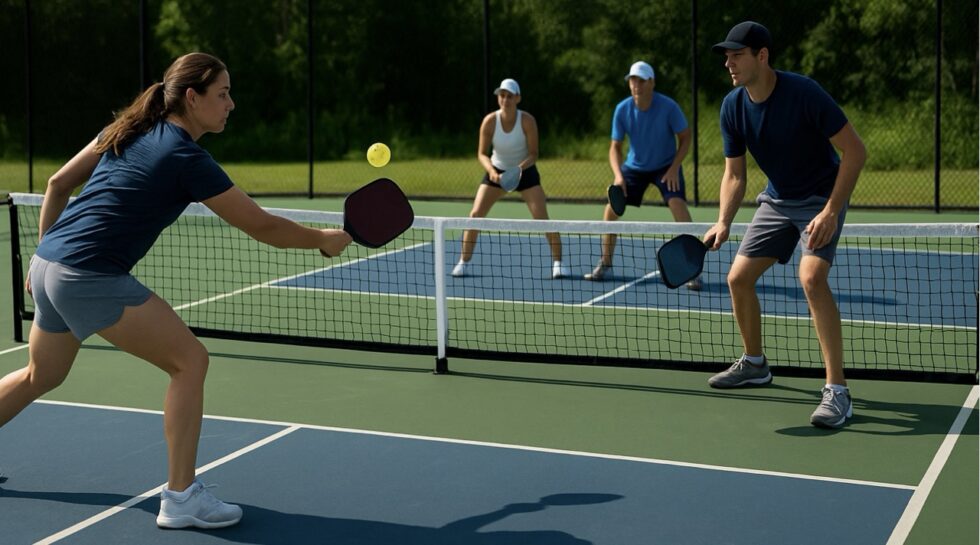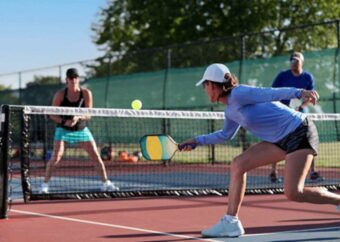What is Pickleball, How Do You Play It – and Where Can You Play in Germany

Pickleball is a racquet sport that blends elements of tennis, badminton, and table tennis. According to G.Business., it was invented in 1965 not in a lab or sports institute, but in the backyard of U.S. Congressman Joel Pritchard on Bainbridge Island, Washington. Together with friends Bill Bell and Barney McCallum, he devised the game to entertain their children using whatever equipment was available: a badminton net, ping-pong paddles, and a perforated plastic ball. The name "Pickleball" reportedly came from the family dog, Pickles.
Since then, the game has exploded in popularity in the United States, where more than 36 million people now play the sport regularly. It is also widely played in Canada, Australia, and now increasingly in Europe—including Germany.
Rules and How to Play Pickleball
Pickleball is typically played on a badminton-sized court (13.41 x 6.10 m) with a net height of 86 cm in the center. The sport uses solid paddles (not strung rackets) and a light plastic ball with holes, similar to a wiffle ball.
Basic rules include:
- Underhand serve, diagonally across the net
- The Two-Bounce Rule: the ball must bounce once on each side after the serve
- Only the serving side can score
- Matches are usually played to 11 points (win by 2)
- Played as singles or doubles
The smaller court size and slower ball make Pickleball easier to learn, especially for beginners, seniors, and players with joint limitations.
Calorie Burn: Pickleball vs. Tennis, Padel, and Poketball
According to the American Council on Exercise, a person weighing around 70–75 kg burns approximately:
| Sport | Calories per hour |
|---|---|
| Pickleball | 350–500 kcal (up to 600 in singles) |
| Tennis | 550–700 kcal (singles) |
| Padel | 500–650 kcal |
| Poketball | 300–450 kcal |
Pickleball is less intense than tennis in terms of running but equally effective in improving coordination and reaction. Poketball—an urban version played on walls with small rackets—focuses more on speed and reflexes than aerobic output.
Health Benefits of Pickleball: Movement, Mind, and Motivation
Pickleball is not only a fun and social activity — it’s also a highly effective form of low-impact physical exercise with proven benefits for cardiovascular health, muscle function, mental sharpness, and overall well-being. Its rise in retirement communities, clinics, and even corporate wellness programs isn’t accidental. Here’s why doctors and physiotherapists increasingly recommend the sport.
Cardiovascular Health: Boosting Heart Function Without Overload
Unlike running or tennis, Pickleball places less stress on the knees, hips, and spine due to the smaller court size and reduced need for high-impact sprints. Still, it elevates the heart rate enough to qualify as moderate aerobic activity, as defined by the American Heart Association.
- Data point: According to a 2021 study in Journal of Aging and Physical Activity, playing Pickleball for 30–60 minutes improves VO₂ max, a key marker of cardiovascular fitness, in adults over 50.
- Why it matters: Maintaining heart rate within 60–75% of max for sustained periods helps reduce blood pressure and improve circulation.
Cognitive and Mental Health: Reaction, Focus, and Stress Relief
Pickleball demands short, reactive movements, constant decision-making, and rapid eye-hand coordination. These requirements stimulate areas of the brain responsible for executive function, balance, and spatial memory.
- Mental stimulation: A study from Western State Colorado University (2018) found Pickleball participants reported improved mood and lower anxiety levels after just six weeks.
- Social interaction: Group-based games like doubles activate dopaminergic circuits through interpersonal engagement, which can combat isolation and depression — particularly in seniors.
Joint-Friendly and Injury-Preventive
Pickleball's underhand serve, lighter ball, and short court distance make it a low-impact activity that is well-tolerated by people with:
- Arthritis
- Osteopenia
- Prior knee or hip replacements
Compared to tennis, where players often cover 5+ kilometers in a match, Pickleball requires less intense lunging and running, making it safer for beginners or those in rehab.
Note: Many physiotherapy centers in the U.S. and Europe now include Pickleball in controlled rehab programs post-surgery or post-stroke.
Muscle Activation and Balance Control
Although movement in Pickleball is less dramatic than in tennis, it engages key muscle groups in:
- Core (rotation and balance)
- Shoulders and arms (paddle control)
- Glutes and quads (lateral movement)
Balance, an essential predictor of fall risk in older adults, is naturally trained in Pickleball. Multiplanar motion (side-to-side and forward-backward) improves neuromuscular control and reflexes.
Weight Management and Metabolic Health
As discussed earlier, Pickleball burns approximately 350–600 calories per hour, depending on intensity. When played regularly (2–3 times a week), it helps maintain a healthy BMI, reduce blood sugar, and support insulin sensitivity — key in diabetes prevention.
Combined with walking or light strength training, Pickleball forms part of an ideal low-risk, high-compliance fitness routine.
Motivation Through Community
One often overlooked health benefit is adherence. Many people quit exercise programs not due to physical strain, but due to boredom or isolation. Pickleball’s social format — doubles matches, round robins, and clubs — makes it motivating and inclusive, leading to consistent participation.
- Players across age groups often describe it as “addictive, in a good way.”
- Pickleball meetups are now offered in many German cities (e.g., Berlin, Cologne, Düsseldorf), often with free introductory sessions for beginners.
Pickleball sits at the crossroads of accessibility, engagement, and health efficacy. It offers a sustainable form of movement for older adults, a coordination booster for younger athletes, and a social outlet for all.
Whether as rehabilitation, stress relief, or aerobic workout — it’s one of the few sports that adapts to you, not the other way around.
Who Plays It
Former tennis professionals like Martin Emmrich (Germany), Andre Agassi, and Steffi Graf have publicly supported and played Pickleball. In 2024, Graf and Agassi beat Maria Sharapova and John McEnroe in a celebrity match in Florida. Stars like LeBron James, Tom Brady, and Heidi Klum have invested in professional Pickleball leagues in the U.S.
Where to Play Pickleball in Germany
Germany has over 70 official clubs registered under the Deutscher Pickleball Bund e.V.. Most are located in Berlin, Cologne, Düsseldorf, Augsburg, and the Taunus region.
| City/Club | Address | Website |
|---|---|---|
| Berlin – TSC Spandau 1860 e.V. | Spandauer Damm 187, 13581 Berlin | germania1926.de |
| Cologne – Pickleball Cologne (DJK) | Ossietzkystraße 125, 50739 Köln | pickleball-cologne.de |
| Düsseldorf – DJK Agon 08 | Lübecker Str. 230, 40233 Düsseldorf | djk-agon08.com |
| Steinhagen – Spvg Steinhagen | Steinbrinkstraße 1, 33803 Steinhagen | spvg-steinhagen.de |
| Dülmen – TV 1884 Dülmen | Mühlenstraße 50, 48249 Dülmen | tv1884duelmen.de |
| Taunus – TV Burgholzhausen | Grävenwiesenweg 5, 61440 Oberursel | tv-burgholzhausen.de |
| Munich – PATO Pickleball | Königinstraße 34, 80802 München (Reitschule) | patopickleball.de |
| Augsburg – 1. Pickleball Club DE | Elisabethstraße 1, 86150 Augsburg | deutsche-pickleball-liga.de |
A full list of clubs and courts is available via deutscher-pickleball-bund.org and pickleheads.com.
Pickleball offers a rare combination of accessibility, enjoyment, and health benefit. While the sport is already booming in North America, it is gaining real momentum in Germany—supported by clubs, players, and former tennis professionals. With rising interest and growing infrastructure, Pickleball could soon become a mainstream sport across Europe.
Stay connected for news that works — timely, factual, and free from opinion — and insights that matter now: How to Use Your Contrast Shower for Health, Immunity and Mental Strength
